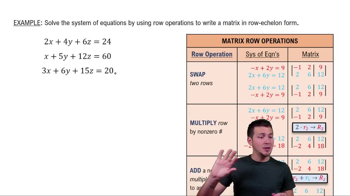Table of contents
- 0. Review of Algebra4h 16m
- 1. Equations & Inequalities3h 18m
- 2. Graphs of Equations43m
- 3. Functions2h 17m
- 4. Polynomial Functions1h 44m
- 5. Rational Functions1h 23m
- 6. Exponential & Logarithmic Functions2h 28m
- 7. Systems of Equations & Matrices4h 6m
- 8. Conic Sections2h 23m
- 9. Sequences, Series, & Induction1h 19m
- 10. Combinatorics & Probability1h 45m
7. Systems of Equations & Matrices
Introduction to Matrices
Problem 33a
Textbook Question
In Exercises 21–38, solve each system of equations using matrices. Use Gaussian elimination with back-substitution or Gauss-Jordan elimination. 
 Verified step by step guidance
Verified step by step guidance1
Write the system of equations as an augmented matrix: \( \begin{bmatrix} 2 & 2 & 7 & | & -1 \\ 2 & 1 & 2 & | & 2 \\ 4 & 6 & 1 & | & 15 \end{bmatrix} \).
Use row operations to get a leading 1 in the first row, first column. You can divide the first row by 2.
Subtract the first row from the second row to create a zero in the second row, first column.
Subtract twice the first row from the third row to create a zero in the third row, first column.
Continue using row operations to create zeros below and above the leading 1s, eventually achieving reduced row-echelon form.
Recommended similar problem, with video answer:
 Verified Solution
Verified SolutionThis video solution was recommended by our tutors as helpful for the problem above
Video duration:
7mPlay a video:
Was this helpful?

 4:35m
4:35mWatch next
Master Introduction to Matrices with a bite sized video explanation from Patrick Ford
Start learningRelated Videos
Related Practice











